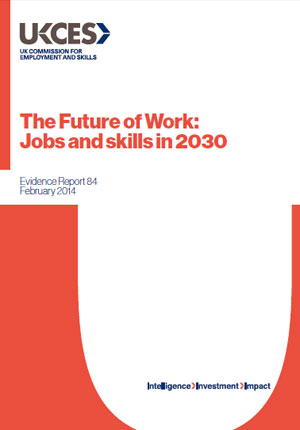Peter Glover is senior research manager at the UK Commission for Employment & Skills (UKCES). UKCES is a publicly funded, industry-led organisation offering guidance on skills and employment issues in the UK. UKCES is responsible giving businesses and people advice on the labour market so they can make informed decisions, carrying out employment and skills policies to develop a workforce that can compete internationally, and helping more employers invest in their employees’ skills.

On the 6th April 2016, the UK Commission for Employment & Skills (UKCES) published the Working Futures Report which predicts, amongst other potential trends, that the number of part-time male workers is set to increase by 20% by 2024 – nearly three times more than the projected growth in part time female workers (7%).
Working Futures

It’s about taking a forward-looking view of the labour market and helping individuals understand the potential trends that we’ll see in the labour market in the medium to longer term. Working Futures doesn’t claim to be a precise prediction of what will happen in the future. What it really offers is a benchmark view of the future, based on projections and drawing on past trends.
So if we see a massive change in the direction of travel in the labour market in the future, Working Futures isn’t designed to pick that up. It’s based around what we have seen in the recent past and how that is likely to develop in the medium to longer term.
Report methodology
It’s the most comprehensive and detailed model of the labour market in the UK that exists, so far as we know. We commissioned a study from the Institute for Employment Research at the University of Warwick. They’re a leading academic organisation with a huge wealth of expertise and knowledge about the labour market.
They way in which the model is developed is through drawing on all the key sources of labour market statistics that are available. So it looks at employment by sector, occupation, employment status, gender and it pulls all that data together into a coherent model of the labour market.
What you get from that is a picture of past trends since 1990, and we can use those past trends as a basis for projecting the future – we can project those trends forward using a range of techniques including econometric techniques, but also using expert judgement from the Institute for Employment Research. What you get is a benchmark picture of what the future may look like from existing trends.
That gives you a basis for debate, and also reflection on what the future labour market may look like, and what the implications are for a variety of groups, including individuals, business, education and training providers, policy makers etc.
Shift toward service employment
In general terms, what we can see from the projections is a continued shift in terms of industry sector, towards service employment. We expect the main source of growth in the labour market to be private sector services, particularly services that operate on the business services side of things, including activities like information technology, business services and so on, but also in the consumer side – trade and distribution type activity.
Manufacturing

Growth in high skilled jobs
In terms of occupations and the jobs that people do, there’s a very pronounced trend towards growth in high skilled jobs – management jobs, professional jobs, and what’s known as associate professional and technical jobs – which are expected to see strong growth, again reflecting what we’ve seen over the last decade.
Growth in lower skilled service areas
The other main area of growth is in lower skilled service areas, and in particular in caring roles, which are expected to see strong growth. There is an aging population so there’ll be a very pronounced requirement for those types of jobs. Also, they’re a type of job that, so far, have proven to be very difficult to automate – some service jobs and other routine jobs have been affected by automation, but this is an area that’s so far been resistant to that.
Decline in middle skilled occupations
In the middle of the labour market, the middle skilled occupations, is where the main areas of decline are expected to be – so administrative and secretarial occupations are expected to be the most pronounced area of decline. Again that reflects the point about technology as so many of those functions can now be automated, so technology is replacing a lot of employment in that area.
Decline in skilled and semi-skilled jobs
Another area of decline is skilled and semi-skilled manual jobs, again reflecting the impact of technology, but also that fact that many of those functions can be carried out more cost effectively elsewhere throughout the world. So you’ve got the migration of some manufacturing activity to Asia and other low-cost centres of production.
Gender related implications
If you’re thinking about what that means in terms of opportunities for men and women, in terms of the growth in high-skilled jobs, the projections suggest that women will be the main beneficiary of that growth. The majority of growth in high-skilled jobs is expected to benefit women as they will get the lion’s share of those additional jobs, based on detailed occupational pattern of growth.
On the other hand though, there are other areas where women are expected to be adversely affected by declining employment, so in particular thinking about administrative and secretarial jobs, looking specifically at secretarial jobs – a broad occupational area that is expected to see the most pronounced decline of all. It is an area that is largely dominated by female employment.
Also thinking about the public / private sector split – a lot of women are employed in the public sector in jobs like administrative jobs, for example, and that’s expected to see quite a notable decline in the first half of the period that we’re looking at – up to about 2019. So there are positives and negatives in terms of female employment.
Part time employment
Looking at employment status, part time employment is expected to be a major area of growth in terms of male jobs. An interesting feature of the growth is that we expect to see part time employment becoming a feature of higher skilled jobs.
In the past, part time employment was often limited to lower-skilled occupations, although that’s not entirely the case – there are other areas where there are relatively high skilled occupations where part time employment has been a feature. Moving forward, part time job growth is expected to outstrip full time employment in many occupations, particularly for men as well in some of those higher skilled occupations.
Self-employment
There are different views about what the outlook is for self-employment and the extent to which the recent very rapid growth in self-employment is due to the economic cycle. So in the last few years we have seen very strong growth in self-employment and the Institute for Employment Research would argue that’s really been a feature of the recession and recovery from recession, so it’s been the case that lots of people have gone into self-employment because they couldn’t find full time employment.
[The Institute for Employment Research would say that] the longer term trend is fairly flat in terms of self-employment and that we will return to that sort of situation now that the economy is in a fairly sustainable pattern of growth, but other people would argue that there’s been a change in the trend and that self-employment will continue to grow strongly. Certainly I think there’s a lot of evidence that more flexible patterns of employment are here to stay.
There are trends in the labour market which point to new business models [like the ‘gig economy’] enabled by technology. The obvious high-profile examples are companies like Uber that can effectively employ freelance drivers on a self-employed basis. The extent to which that is going to permeate the wider economy, probably over the longer term is going to be a major feature. The Working Futures projections suggest a fairly flat picture in terms of self-employment, but in the very long term there are trends towards much more flexible patterns of work and new business models.
In addition to Working Futures a couple of years ago we published a report called The Future of Work, which rather than providing a quantitative model of the labour market, looks at some of the trends that we pick up from qualitative research, and that points towards changing attitudes amongst the labour force, so there’s a whole piece about Generation Y and their differing attitudes to the workplace as compared with older workers. It also covers this general trend towards a desire for greater flexibility, greater work / life balance. That’s something that’s quite difficult to quantify, but the report highlights that as an underlying trend in the labour market.
Women in STEM
In terms of STEM, we published another report called The STEM Review. We were asked to provide an assessment of labour market need for higher level STEM occupations. Although it wasn’t the main focus of the report, it looked at patterns of gender in some of those occupations, and what it clearly showed was that the occupations with the greatest labour market need are the ones where women are most poorly represented. If you consider broad occupational areas like engineering professionals, IT professionals, which are large areas of employment with strong growth prospects, characterised by significant skill shortages, the representation of women in those areas is relatively low, so the argument could be that a key area for action would be to try and improve female representation there in order to improve the supply of labour for those occupations.
The Future of Work

It’s about leveraging those wider networks in order to meet business objectives. What that entails is greater flexibility for individual workers, in terms of the way they are employed or in the way in which they engage with these newer business models. It can also involve global value chains as well, so the company’s extended workforce can be distributed internationally.
There are a whole host of implications arising out of that, one of which would be the need for greater self-reliance amongst workers, and also for the need for those workers to take greater responsibility for the development of their own skills. That might include skills around self-management if they’re managing a portfolio of different work assignments.
https://www.gov.uk/government/organisations/uk-commission-for-employment-and-skills
https://www.youtube.com/user/TheUKCES





